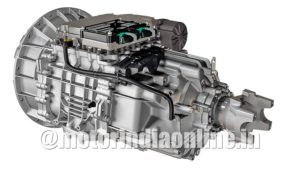Transmission efficiency assumes critical significance in heavy-duty applications. Optimising mechanical efficiency of gearboxes and fashioning multi-speed transmissions for electric CVs are becoming viable business cases.

Back when automobiles were invented, they were fairly simple with just a few mechanical parts. Yet, they were still complex for their time. As with any evolution – may it be that of natural science or man-made engineering – complexity steps up with time. It is beneficial and crucial for further progress. Since day one, transmissions have always been the most complex hunk of an automobile. Thanks to some 800-minute pieces of meticulously engineering and intricate operation of the system as a whole, added with a motley of electronics, the automotive transmissions continue to intrigue us even today.
Just like natural evolution, the quest for efficiency is at the heart of automotive engineering. Improving performance and fuel economy by reducing NVH and energy wastage at all stages remains to the prime focus. This pursuit has assumed even greater importance in present times, with the industry facing stringent emission norms and new challenges out of hybridisation and electrification. In other words, the emission reduction targets are pushing the industry towards further development and refinement of not just powertrain and energy storage technologies, but also future transmission systems that could optimise efficiency in a better way.
Automation of transmission in one form or the other has already begun. As far as mechanical efficiency is concerned, the bearings and gearset designs are getting refined, while shift and clutch actuation systems are pepped-up to be frugal in energy consumption. Electro-hydraulic actuation is being worked out for improved ratio control and cut drag losses, along with the application of low-viscosity oils to reduce drag torque. Overall vehicle efficiency will also depend on how effectively integrated transmission is with the rest of the power system, especially in the case of hybrids. The new-generation DCTs and CVT gearboxes for cars are making strident progress in all these common focus points.
All the more, transmission efficiency assumes critical significance in heavy-duty applications. Two reasons – things remain less explored in this space owing to certain legacy constraints unlike passenger cars, while ‘efficiency’ can be amplified as commercial vehicles may even cover over 1,00,000 km per year, which means any emission reduction and fuel-saving out of new improvements would be far-reaching. It’s only in recent decades that automatic gearboxes – notably AMTs – are gaining some popularity, with drivers and operators becoming open to the adoption of predictive shifting. Suppliers are stepping-up the ante with innovation and further refinement of AMTs. For long-haul vehicles that run predominantly on highways in near-constant speed, mechanical efficiency is the top priority.
Take, for instance, the ‘Endurant’ 12-speed AMT developed by the Eaton Cummins Automated Transmission Technologies with a purpose-built approach. It is light in weight, fully-integrated with telematics for predictive maintenance and quicker repair diagnosis. Most interestingly, this gearbox uses nozzles for precise delivery of oil to the gears and bearings – they are no longer submerged in oil – effectively reducing the oil requirement by half. Also, the twin countershaft design reduces side-load on the main shaft, thereby eliminating tapered roller bearings and ensuing mechanical losses. The system also offers a cost-effective lubricant change interval of 12,00,000 km, longer by 4-7.5 lakh km than its rivals – a boon for fleet operators.
Hybridisation is another harbinger of change in heavy-duty transmission designs. The advent of the latest natural gas engines warrants optimisation of transmission control tuning, as throttle response of gas is very different from that of diesel. Last, but not the least, although a majority of EVs these days feature single-speed transmissions with fixed gearing ratio, multiple gears can offer even better efficiency. It is predicted that the first mainstream application of multi-speed electric transmission might happen in heavy-duty applications, much ahead of passenger cars, as business cases work in their favour. For trucks, in particular, multiple ratios can help balance low-speed torque with high-speed economy for highway hauling. Volvo Trucks is ready with a 2-speed transmission for its electric FL and FE series. I recently test drove in Europe the latest Volvo 7900 electric bus mated to a similar 2-speed gearbox, it was a sneak peek experience into the future of heavy-duty transmissions.